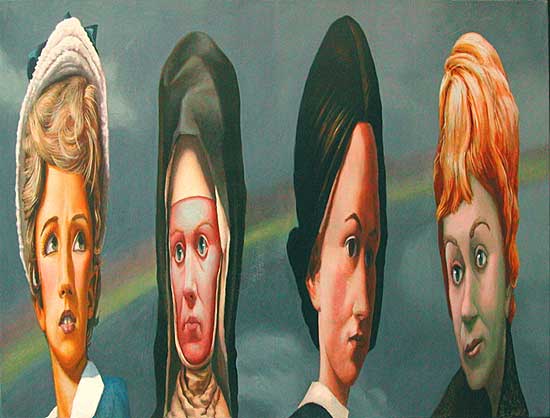New Work:
Adela Leibowitz
"May Apple"
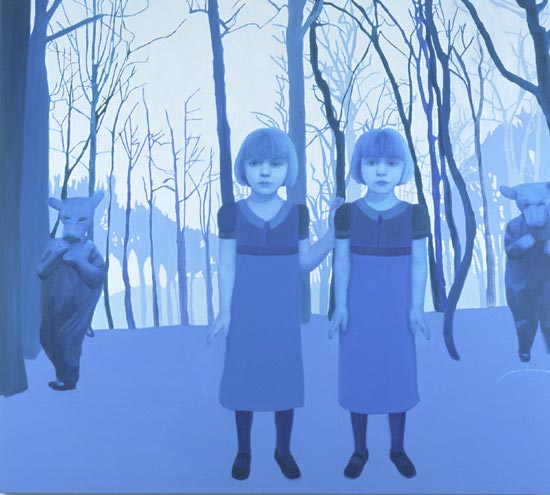
Artist's Statement
Adela Leibowitz shows us her world of fable like paintings of little girls lost in eerie blue landscapes. Time travel to the days when monsters walked the earth with us, legends abounded of cursed exchanges between animals and people, and deer trapped on a floating iceberg in the wide open sea are just a few of the sinister warning tales. The little girls are both the watchers and instigators in the unfolding scenes. Questions and investigations of existential angst, power dynamics and mortality are explored in Leibowitz?s finely rendered paintings where outcomes are left to be seen in a distinctly dual light.
www.adelaleibowitz.com
New Art from the May, 2005 Chicago Art in the Park and Nova Shows from Jack the Pelican Presents in Brooklyn.
Maria Capolongo
"You Want This!"
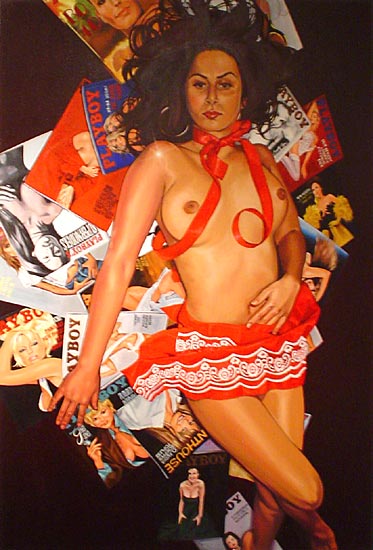
Amy Pina
"Nude Self Portrait"
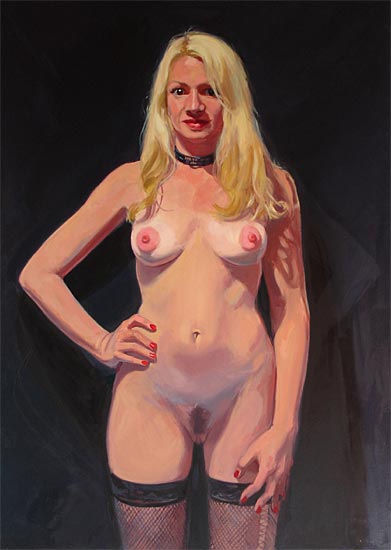
John Jodzio
"La Corrida en la Ghetto"
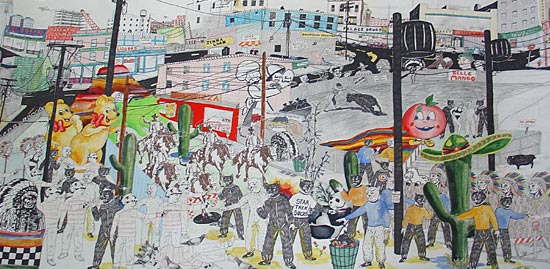
Caleb Weintraub
"Party Favors"
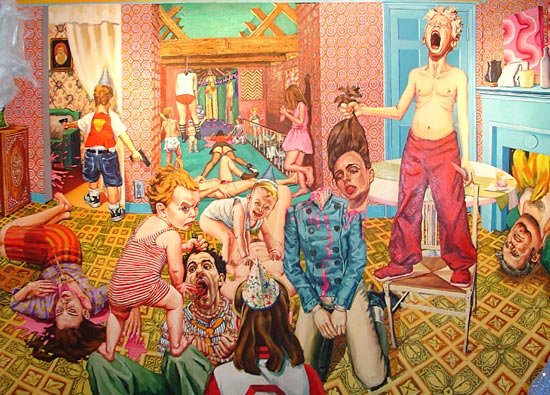
Artist's Statement:
When the Bough Breaks
By Caleb Weintraub
My artwork is an accusation. The future is the accuser; we are the accused. Through paintings, drawings and work in other media, I address issues of over-stimulation and desensitization - the disintegration of moral and spiritual awareness and the absence of accountability in our culture. I conjure a world of excesses and extremes – a world not dissimilar from our own – where the inhabitants can no longer distinguish between good and evil, love and hate, hunger and greed.
Here children reign supreme; they turn against parents, assume adult roles, and function outside the normal realm of behavior and experience. The works address a culture that has lost its ability to be scandalized. Events that might otherwise seem obscene or horrifying are delivered in candy colors with vibrating patterns and spattered saccharin blood the color of pink bubble gum. By incorporating elements of exaggeration and distortion, I aim to infuse my work with satire, to unsettle viewers by encouraging them to consider the consequences of indulgence.
There is a universal distaste in the West for all things irrational. This distaste has led our nation out of the grip of archaic law and imposed religion. It has yielded some of the greatest achievements in human history including the collapse of slavery, the birth of women's rights and equal rights. Nevertheless, there have been consequences and byproducts to this state of reason that have made human spiritual experience abstract if not obsolete. And the same liberating impulse that has won us our freedom, poses a great threat to our society.
Through my work, I evoke a world in which our progressivism has resulted in an inability to judge – a world in which all limitations are seen as uncivilized -- a world where courtesy has crippled spirit and children are left without direction.
Though cynicism plays a role in my work, I am deeply optimistic and it is this optimism that drives me to color my vision with the grotesque and the farcical. By altering our reflection, I aim to expose a cultural force that is greater than the sum of its parts, to bring it into the arena of the mind and to ignite a reevaluation of humanity.
Painting as a medium is embedded with a deep and meaningful history. I rely on this history as a link to which I can attach the narratives of my work. As a child I was deeply affected by the works of Bosch, Bouts, Memling and Bruegel. These artists painted airless environments that often depicted absurd conditions and consequently seemed to allude to a reality not fixed in time but in imagination. Similarly, the movies of Jean-Pierre Jeunet inspired me with their visual and narrative complexity.
At the same time, I was influenced by the popular culture in which I grew up. The slick and off-color illustrations of Mad magazine and Garbage Pail Kids, and the artifice of WWF wrestling all had a hand in shaping my current artistic vocabulary.
By referencing the idyllic painted worlds of the old masters, and subverting that world, I hope to make the devastation of the fantasy universe that occurs in my work all the more salient, as if to say, look at how our myths have come undone.
Recent Review of Caleb Weintraub Work:
Caleb Weintraub, a recent graduate of BU and UPenn MFA as his “work is about over stimulation and desensitization” as electronic music is often employed to illustrate in films and television. His paintings are about much more than desensitization, however, they may demonstrate it more than anything else. I fear that this work will be lost in the rather vast amount of work that seeks to comment on “the disintegration of moral and spiritual awareness and the absence of accountability in our culture,” yet actually only ends up participating within the same culture.
The paintings themselves are a cartoonish hell: babies and young children with oversized eyes point hand-guns into their faces and stand pregnant with tearful looks on their round cherubic faces, a cherub army massacres a city square. They are painted in a style that emulates the old European masters such as Poussin who Weintraub seems to reference not only in style but with cherubs throwing bombs and shooting guns instead of tossing apples from an apple tree. The cartoonish quality of the works comes from its simplifications, simplifications in the same way that Poussin simplified his subjects—wrinkles, blemishes removed, the features most useful for portraying beauty left intact and often embellished. Cartoons simplify and exaggerate for purposes of humor or identification of or with. The children’s eyes enlarged as has become the common style in American cartoons (after Japanese), from Disney films to South Park.—it was indeed South Park that introduced the nation to the hilarity of cursing children paralleling Weintraub’s work with its themes of desensitization.
The choice of children to articulate his themes is a reference to the old masters with their cherubs and children signifying innocence, but in his work, their presence is purely ironic. The use of children may also be more about pedophobia as there is a long standing and extremely successful tradition of pedophobic horror films, which Weintraub may very well be aware of, unless he himself is indeed afraid of children. The painting style is indeed ironic as well, evoking a pathos that works against the subject of the work. Irony, or sarcasm, as may be the central theme here, is a prevalent phenomenon in our society today as it undoubtedly informs Weintraub’s work.
There are undoubtedly countless other ways to demonstrate over stimulation and desensitization both in an artists choice of subject matter and medium. Why work in painting? Painting as a medium holds only a fleck of the cultural relevance as it did when his heroes graced the courts of the Renaissance and Enlightenment, it is now considered to be a decadent commodity and gesture. One may argue that, without our history of painting, the imagery of our present culture (e.g. mass media) would have not be comparable to what it is today, but that still leaves his work in a relatively esoteric niche.
Painting is thought to have the ability to create the most potent images, whether ideologically or emotionally, painting enables the artist to pull the strings of the viewers’ emotions more effectively than any other visual medium, except cinema, but try to image an entire film as silky and luminously gorgeous as a Vermeer. Weintraub believes that the works of the old masters lacked truth, however. He posits that it can only be attained through the extreme; but artwork that aspires for the extreme fuels the same culture that he wishes to deconstruct.
Weintraub also works in video and may find that working with such a medium may function more effectively at achieving the specific excess and extremes his work is about. Mass media is the main proponent of “culture that has lost its ability to be scandalized” as he seems to imply in his statement. It is perhaps even the reason it apparently became that way.
Art from prior Jack the Pelican Presents shows.
The Hedonistic Imperative includes work by James Adams, Matt Borruso, Paul Jacobsen, Ted Mineo and Jerry Kearns, among others.
Press Release:
Jack the Pelican is pleased to present “The Hedonistic Imperative,” guest-curated by Graham Guerra. The show is a tribute to David Pearce’s 1996 online manifesto of the same name, which calls for the elimination of suffering in all sentient beings through genetic engineering, nanotechnology and neuroscience. “The world’s last unpleasant experience,” he writes, “will be a precisely dateable event.”“Techno-feel-goodness in futureworld is anodyne delicious,” says curator Guerra, a recent Yale MFA who solo’d at Jack the Pelican last Spring, “The clumsy boy style of last year’s fashion in painting is soft comfort food. I'm into something less regressive, more positive.” The 12 artists in this exhibition wield technologies new and old, and often in combination, with virtuoso pharmacological precision to imagine the idyllic silicon-enhanced future of our technicolor “super well” descendants. It is a paradise. Paul Jacobsen casts a glint of sunlight in the starring role of Gone to Croatan, his painting of a buxom maiden sprawled in the lush valley of futureworld. Kim Keever, in 2 photos, summons from the depths of a one-hundred-gallon tank the high baroque drama of yo-Western landscapes. Suzanne Walters paints deer-like figurines frolicking in a hazy polychrome bliss. Robert Yarber unveils an altogether new body of work of merry prancers sortie-ing through the muddy plain in celestial armillary bubbles.Desire is sated. Ted Mineo woofingly circumambulates his own initials with lovingly rendered, dough-eyed vixens. Video artist Michael Joaquin Grey re-choreographs the love motions of a very young Traci Lords and partner to the Simon & Garfunkel classic “Mrs. Robinson.” Matt Borruso’s candy colored clown is high on his own sugar.The mutant body is pleased with itself. The gimp or headless satyrs and nymphs in James Adams’ paintings seem unaware they are anything other than perfectly made. Carl D’Aliva sculpts resin “Cousin It” hair coats for his dog with a V8 engine for a head, his “manolith” and his monkey. Michael Rees rapid-prototypes headless arachnid-beasts from giant human fingers and legs. In his animations, he documents their first steps. Norm Paris overlays the anamorphic contours of specimen males Chris Dickerson, Boyer Coe and Arnold Schwarzenegger, in celebration of multi-dimensional man. And Jerry Kearns paints bodybuilder Jesus in a field of poppies.
Recent pieces purchased by HAT include the following:
Peter Caine "Officer Lard Ass"
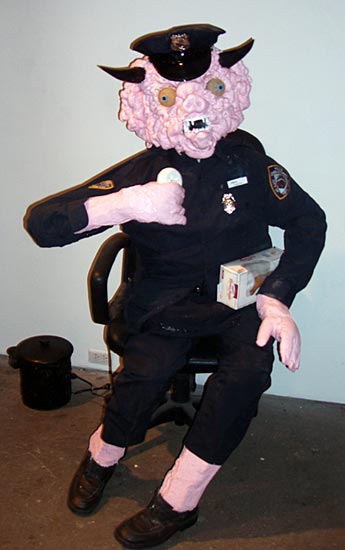
ARTIST'S INFORMATION
Peter Caine outdoes himself with multiple figure installations of dazzling ambition, the likes of which few amusement houses have ever seen. Lights, sounds, voices and sheer quirky madness combine with homespun animatronic bravado to create a spectacle of dark Baroque magnificence.
There is his life-size ship of fools near the gallery's entrance--Dorothy and the Tin Man crossing the Delaware with George Washington, Prince Whipple and a very talkative Barbara Bush, gushing over the prodigious member of the Marquis de Sade, literally a fountain of spewing jism. A critter greeting them on the marshy shore identifies himself as a beaver and he demands to be shaved.
Just beyond, a forest of eight- and nine-foot tall nyloned and Brancusi-esque Cabana Boys wriggle to a silent, funky beat. Some are striped like Pippy Long-stocking and one, the beast of the bunch, sprouts long cascades of synthetic hair. In their shadow is an angry God, handsomely feathered with the hackles of partridges and pheasants and swelling with bursts of light, as he pronounces his indignation.
Towards the rear of the main gallery is Rudolph the Red-nosed Reindeer, pulling along a shuffling, homeless black Santa with his shopping cart of wonderland toys. They and friends are on their way to Rehab Island. Santa sings Christmas in a deep bass. Rudolph squeaks out an hilarious and irreverent six-minute testimonial.
With animatronic prowess, Caine transforms the back gallery into a gloriously beautiful undersea world, teeming with tropical fish. This coral reef is a nuclear dumping ground, littered with containers of radioactive waste from a nuclear submarine. A navy diver takes Geiger readings. He radios his commanding officer on the USS Sperry, a sub-tender out of Port Loma, California that floats in miniature on the surface above. As the channels get mixed with a civilian ordering takeout from Long John Silver's, an audio play ensues. The scene echoes an incident from Caine's own tour of duty on the ship, when he was routinely forced to participate in the dumping of nuclear waste.
Peter Caine is a self-taught artist, raised in Saint Louis. He began making collages while recovering from a crippling leg injury at the US Naval Hospital in Jacksonville Florida. His massive installation Overseer at PS 1's "Greater New York" was among the hits of the show. Reviews of his work have appeared in many publications, including Art News, The New York Times and Art Forum.
Paul Jacobsen "Gone to Croatan"

Matt Borruso "Harlequin"
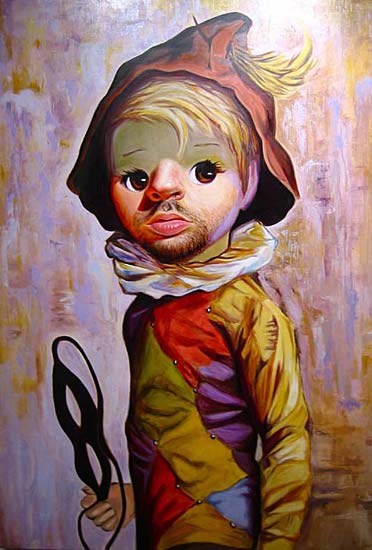
James Adams "rhead"
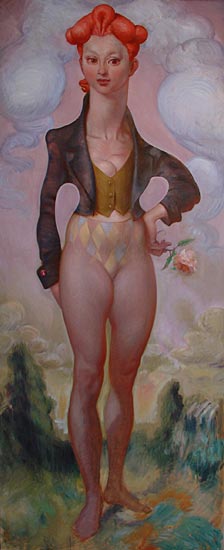
Robert Zeller "Deep Dish"
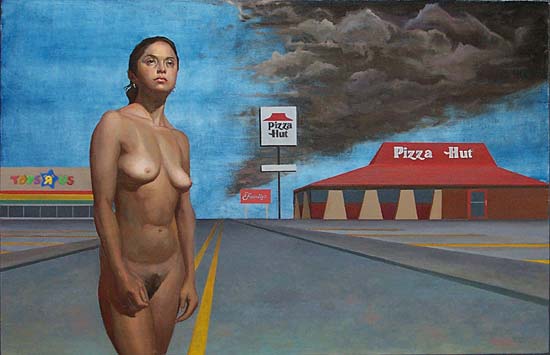
Artist's Statement by Robert Zeller
I am presently working on a series of paintings about the sythesizing of two Western concepts. One is the icon of the nude female, a staple of almost all major periods in Western art. The other is the American landscape, but in a contemporary form - the shopping mall.
Much like the Italian piazzas and small town squares all over Europe, the suburban shopping mall is the center of American commerce. Malls have often fufilled the traditional functions of a community center. They are where we buy our clothes, food and are entertained (movies, Santa Claus, ice rinks,etc.)
Most European squares have some sort of statuary, civic or religious, as a centerpiece. I have chosen to depict the live female nude in place of that statuary since females and their bodies are the main focus of consumerism in our country.
Suburban malls require enormous amounts of space.This is an important element of the series. I want to create a sense of lonely, wasted space. The American ideal of Manifest Destiny and the slogan "Go West, young man" have given way to suburban sprawl. Ifind this a sad, yet intractible part of American life.
On a technical level, I am combining a version of 19th century figure modeling with 16th century perpective techniques.I leave a good portion of the ground exposed as well as some of the perspective grid.
Robert Zeller's website: http://www.robertzeller.com
John Jacobsmeyer "Jamie Somers"
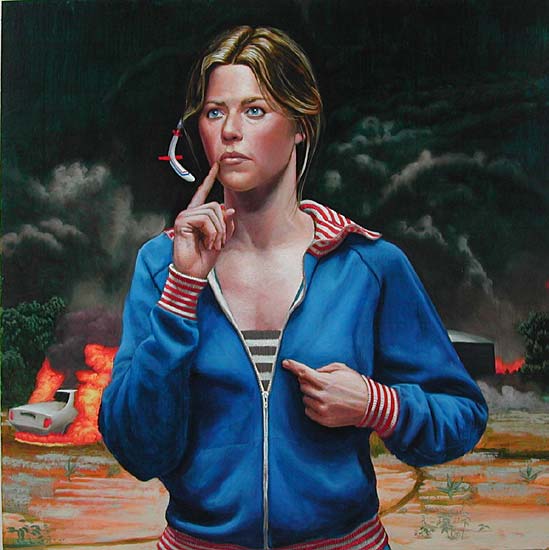
Artist's Information:
John Jacobsmeyer imparts a pathetic, world-weary dignity to pop superheroes and freaks of the realm, like The Attack of the Fifty Foot Woman Nancy Archer. Jacobsmeyer uses masterful and studied oil technique, reminiscent at times of the Cinquecento mannerists Agnolo Bronzino, Giulio Romano and Il Parmigianino, to turn action-figure plastic and news flash and B-flim celluloid into palpable humanized flesh. But, with characteristic discombobulation, he refigures the expansive, courtly gestures of the old masters into American Sign Language, to fall on deaf eyes with pleas of help for a world gone sick.
Further twists in Jacobsmeyer’s manifestly allegorical paintings hinge on anamorphic representations of Good and Evil buried into the surround. In Steve Austen Does Not See the Enemies of Democracy, vigilant anti-communists of the 1950s hide in the stripes of the American flag. In his painting of Ham, first monkey in space (lost forever in the abyss), one can see from the chimp’s perspective the schoolboy-ish poster of Jane Goodall that decorates the capsule’s otherwise Spartan décor.
The grand old world tradition of painting in which Jacobsmeyer works had a brief dessicated revival in the 1930s with high kitsch Social Realism. Vintage WWII (golden age) comics soon transmuted the idealized bodies of Socialist workers into pop superheroes for little boys. For the next several decades, comic books and pulp science fiction books and films continued to mine Cold War anxieties and ambivalence towards science with celebrations of radicalized supranatural anatomy—with hundreds of variants of nuclearized or alienated flesh. Jacobsmeyer restores the complex awkwardness of human depth to these conventional and one-dimensional figures of righteous justice. Presented up close and intimate, they are by turns vulnerable, self-conscious, frightened and ashamed. And, they are likeable.
Jacobsmeyer also working on book of beastly wood engravings extrapolated from James Dickey’s poem, “The Sheep Child.”
A New Hampshire native, and Yale MFA, Jacobsmeyer has lived in New York for six years. Since 1999, he has been a Graduate Instructor at New York Academy of Art. He is the winner of numerous awards, including a Pollock Krasner and a Fulbright.
John Jacobsmeyer's website: http://WWW.JOHNJACOBSMEYER.COM
PRIOR PURCHASES FROM THIS GALLERY INCLUDE:
John Jacobsmeyer "Possible Mothers"
